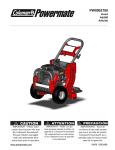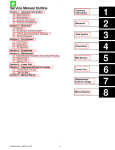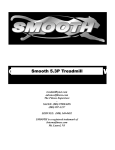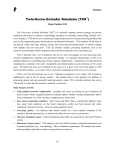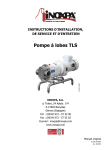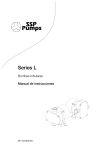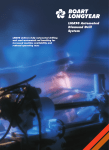Download Dayton 1UG91C Operating instructions
Transcript
6AKY2 Operating Instructions & Parts Manual Please read and save these instructions. Read carefully before attempting to assemble, install, operate or maintain the products described. Protect yourself and others by observing all safety information. Failure to comply with instructions could result in personal injury and/or property damage! Retain instructions for future reference. Dayton Wet/Dry Vacuum ® Commercial / Industrial Use Description Dayton wet/dry vacuum cleaners are for vacuuming wet and dry non-combustible materials. Equipped with powerful, permanently lubricated, single-stage by-pass motors. Features: motor housing, blower port, long power cord, convenient on-board tool storage, rugged dent resistant, rust proof plastic tank. Includes versatile deluxe accessory make-up and efficient filtration. cULus (6AKY2) Specifications Model 6AKY2 Tank Style Plastic Tank Capacity Electrical Rating 10 Gal. 120V, 60 Hz AC 12 Amps (38 liters) Static Pressure Air Movement Weight 60" 195 cfm 21 lbs (152.9 cm) (5.5m3/min) (9 .5 kg) Filters Cartridge and Collection Bag Important safety instructions ALWAYS WEAR EYE PROTECTION Never operate this unit when flammable materials or vapors are present because electrical devices produce arcs or sparks that can cause a fire or explosion. never operate unattended! When using an electrical appliance, basic precautions should always be followed including the following: Read all instructions before using this appliance. To reduce the risk of fire, electric shock or injury: 1. Do not leave appliance when plugged in. Unplug from outlet when not in use and before servicing. Connect to a properly grounded outlet only. See Grounding Instructions. 2. Do not expose to rain–store indoors. 3. Do not allow to be used as a toy. Close attention is necessary when used by or near children. 4. Use only as described in this manual. Use only Manufacturer’s recommended attachments. 5. Do not use with damaged cord or plug. If appliance is not working as it should, has been dropped, damaged, left outdoors or dropped into water, return it to a service Form 5S6688 center. 6. Do not: pull or carry by cord, use cord as a handle, close a door on cord or pull cord around sharp edges or corners. Do not run appliance over cord. Keep cord away from heated surfaces. 7. Do not unplug by pulling on cord. To unplug, grasp the plug, not the cord. 8. Do not handle plug or appliance with wet hands. 9. Do not put any object into openings. Do not use with any openings blocked; keep free of dust, lint, hair and anything that may reduce air flow. 10. Keep hair, loose clothing, fingers and all parts of body away from openings and moving parts. 11. Do not pick up anything that is burning or smoking, such as cigarettes, matches or hot ashes. 12. Do not use without dust bag and/or filters in place. 13. Turn off all controls before unplugging. 14. Use extra care when cleaning on stairs. 15. Do not use to pick up flammable or combustible liquids such as gasoline or use in areas where they may be present. 16. Do not use your cleaner as a sprayer of flammable liquids such as oil base paints, lacquers, household cleaners, etc. 17. Do not vacuum toxic, carcinogenic, combustible or other hazardous materials such as asbestos, arsenic, barium, beryllium, lead, pesticides, or other health endangering materials. Specially designed Printed in U.S.A. 07985 Version 1 01/2013 E N G L I S H units are available for these purposes. 18. Do not pick up soot, cement, plaster or drywall dust without cartridge filter and collection filter bag in place. These are very fine particles that may pass through the foam and affect the performance of the motor or be exhausted back into the air. Additional collection filter bags are available. 19. Do not leave the cord lying on the floor once you have finished the cleaning job. It can become a tripping hazard. 20. Use special care when emptying heavily loaded tanks. 21. To avoid spontaneous combustion, empty tank after each use. 22. The operation of a utility vac can result in foreign objects being blown into eyes, which can result in eye damage. Always wear safety goggles when operating vacuum. 23. STAY ALERT. Watch what you are doing and use common sense. Do not use vacuum cleaner when you are tired, distracted or under the influence of drugs, alcohol, or medication causing diminished control. 24. WARNING! Do NOT use this vacuum cleaner to vacuum lead paint debris because this may disperse fine lead particles into the air. This vacuum cleaner is not intended for use under EPA Regulation 40 CFR Part 745 for lead paint material cleanup. 87548-46 ® E S P A Ñ O L F R A N Ç A I S 6AKY2 Dayton Operating Instructions and Parts Manual Dayton Wet/Dry Vacuum ® SAVE THESE INSTRUCTIONS E N G L I S H Do not leave Vacuum unattended when it is plugged in and/or operating. Unplug unit when not in use. GROUNDING INSTRUCTIONS This appliance must be grounded. If it should malfunction or breakdown, grounding provides a path of least resistance for electric current to reduce the risk of electric shock. This appliance is equipped with a cord having an equipmentgrounding conductor and grounding plug. The plug must be inserted into an appropriate outlet that is properly installed and grounded in accordance with all local codes and ordinances. Improper connection of the equipmentgrounding conductor can result in a risk of electric shock. Check with a qualified electrician or service person if you are in doubt as to whether the outlet is properly grounded. Do not modify the plug provided When using the appliance at a distance where an extension cord becomes necessary, a 3-conductor grounding cord of adequate size must be used for safety and to prevent loss of power and overheating. Use the table below to determine A.W.G. wire size required. To determine ampere rating of your vacuum, refer to nameplate located on motor housing/ cover. Before using appliance, inspect power cord for loose or exposed wires and damaged insulation. Make any needed repairs or replacements before using your appliance. Use only three-wire outdoor extension cords with the appliance—if it will not fit the outlet, have a proper outlet installed by a qualified electrician. This appliance is for use on a nominal 120-volt circuit, and has a grounded plug that looks like the plug illustrated in sketch A. A temporary adapter that looks like the adapter illustrated in sketches B and C may be used to connect this plug to a 2-pole receptacle as shown in sketch B if a properly grounded outlet is not available. The temporary adapter should be used only until a properly grounded outlet (sketch A) can be installed by a qualified In Canada, the use of a temporary adapter is not permitted by the Canadian Electrical Code. Make sure that the appliance is connected to an outlet having the same configuration as the plug. No adapter should be used with this appliance. IF THE CORD IS DAMAGED, IT MUST BE REPLACED BY A SPECIAL CORD OR ASSEMBLY AVAILABLE FROM THE MANUFACTURER OR HIS authorized service agent. EXTENSION CORDS which have three prong grounding-type plugs and three-pole receptacles which accept the extension cord’s plug. When vacuuming liquids, be sure the extension cord connection does not come in contact with the liquid. NOTE: Static shocks are common in dry areas or when the relative humidity of the air is low. This is only temporary and does not affect the use of the appliance. To reduce the frequency of static shocks in your home, the best remedy is to add moisture to the air with a console or Unpacking 1. Pull lid latches in an outward motion and remove tank cover and any accessories which may have been shipped in the tank. 2. Before replacing tank cover, refer to Dry Pick Up or Wet Pick Up Operation in this manual to ensure you have the proper filters installed for your cleaning operation. 3. Replace tank cover and apply pressure with thumbs to each latch until it snaps electrician. The green colored rigid ear, lug or the like extending from the adapter must be connected to a permanent ground such as a properly grounded outlet box cover. Whenever the adapter is used, it must be held in place by a metal screw. 4. 5. 6. 7. tightly in place. Make sure both lid latches are clamped securely. Attach dolly following the instructions and illustrations in this manual. Insert long machine hose end with locking-nut into inlet of tank and tighten. Do not over-tighten. Attach the extension wands to the accessory end of the hose. Twist slightly to tighten the connection (Figure 1). Attach one of the cleaning accessories 2 installed humidifier. Volts 120V Ampere Rating More Not More Than Than 0-6 6-10 10-12 12-16 Total length of cord in feet 100 150 25 50 AWG 18 18 16 14 16 16 16 12 16 14 14 14 12 12 Not recommended (depending on your cleaning requirements) on the extension wands. Twist slightly to tighten the connection (Figure 1). 8. Plug the cord into the wall outlet. Your cleaner is ready for use. I = ON , O = OFF 1 Dayton Operating Instructions and Parts Manual Model 6AKY2 Assembly which can cause a fire or explosion - do not use at filling stations or anywhere gasoline is stored or dispensed. 2 Dolly Operation Attaching Dolly To attach dolly to bottom of tank, lift vacuum using the top handle. Position vacuum 3 above dolly with the front of the vacuum facing the front of the dolly (side with the release lever) (Figure 2). Place tab on back bottom of tank into slot in back of dolly (Figure 3). Push downward on front of vacuum until front of tank clips 4 into lever on dolly (Figure 4). (Not standard with all models) 9 10 11 12 13 Clean or replace filters regularly. Do not use the vacuum or filters for collecting hazardous or other health endangering materials. NOTE: Never machine wash or dry filters. TOOL HOLDER ASSEMBLY 8 NEVER OPERATE UNATTENDED! Keep Filters Clean The efficiency of these vacuum cleaners is largely dependent on the filter. A clogged filter can cause overheating and possibly damage the vacuum cleaner. Removing Dolly To remove dolly, gently push downward on the release lever with your foot. While holding the release lever down, lift 5 upwards on vacuum using the top carry handle (Figure 5). Note: When using the vacuum to pick up very fine dust such as sawdust or dry wall dust, it will be necessary to empty the tank and clean the filter at more frequent intervals to maintain maximum pick up power or upgrade to collection filter bags. 1. Replace tank cover and 6 apply pressure with thumbs to each latch until it snaps tightly in place. Make sure both lid latches are clamped securely. 2. With rear of unit facing you, take tool holder and position 7 it with the tabs facing rear tank cover (Figure 6). 3.Press tabs of tool holder into the slots on mounting lugs on rear of tank cover (Figure 7). 4.Press down until tabs snap into place. ALWAYS DISCONNECT THE PLUG FROM THE WALL OUTLET BEFORE REMOVING THE TANK COVER. Operation This equipment incorporates parts such as switches, motors or the like that tend to produce arcs or sparks that can cause an explosion. Do not pick up flammable, combustible, or hot materials. Do not use around explosive liquids or vapors, as electrical devices produce arcs or sparks 14 DRY PICK UP OPERATION NOTE: If foam sleeve (Not standard with all models) is in position over lid cage, it does not need to be removed before installing cartridge. Foam must be positioned on the INSIDE of groove around lid cage for cartridge to fit properly. The cartridge filter can be used for wet or dry pick up; installation is the same for both. When picking up large quantities of liquid please refer to the Wet Pick up Operation section in this manual. Use the cartridge filter in position over the lid cage for most general dry material pick up. Make sure inlet deflector is fully inserted into deflector guide on inside of tank. If it is not, install inlet deflector by sliding it downward into slot on deflector guide (Figure 8). NOTE: Hose must be removed before inlet deflector can be inserted into or removed from deflector guide. Opening on inlet deflector can face either side of tank. Inlet deflector should always be in place for any type of cleaning. With the tank cover in an upside down position, slide the cartridge filter down over the lid cage, pushing until the filter seals against the cover (Figure 9). Place filter retainer into the top of the cartridge filter, hold the tank cover with one hand, turn the handle on the filter retainer clockwise to tighten, locking the filter into place (Figures 10 & 11). To remove the filter for cleaning, again hold the tank cover and turn the filter retainer counterclockwise to loosen and remove, slide the cartridge filter off the lid cage (Figures 12 & 13). To clean the cartridge filter shake or brush off excess dirt or rinse (from the inside of the filter) with water, dry completely (approximately 24 hours) and re-install (Figures 14 & 15). Note: If the filter has been used for wet pick up, it must be cleaned and dried before using for dry pick up. 15 Installing collection Filter Bag (Not standard on all models) 1. Use for dry pick up only. Use in conjunction with cartridge filter for picking up soot, cement, plaster or drywall dust. 2. With cord disconnected from receptacle, pull latches in an outward motion and remove tank cover. 3. Unscrew hose locking-nut and remove hose from inlet (Figure 16). 4. Remove inlet deflector from deflector guide (Figure 17). NOTE: Hose must be removed before inlet deflector can be taken out. 5. With the opening of the inlet deflector facing the left or right side of the filter bag, slide filter bag collar over deflector matching notches of bag collar to tabs on inlet deflector, bag will only fit properly one way (Figure 18). 6. Slide deflector with collection bag attached into deflector guide (Figure 19). 7. Reinsert hose into inlet and tighten locking-nut (Figure 20). 8. When secured in place, expand bag and position around the inside of the tank. 16 17 ® 3 E N G L I S H 6AKY2 Dayton Operating Instructions and Parts Manual Dayton Wet/Dry Vacuum ® Operation (Continued) 18 E N G L I S H 19 20 NOTE: When removing filter bag from tank, remove inlet deflector from filter bag collar and reinstall into deflector guide. Inlet deflector should always be in place for any type of cleaning. WET Pick up OPERATION Remove ALL dirt and debris found in the tank. The vacuum 21 requires only a minimum of conversion when going from dry to wet pick up. Remove all dry use filters from the vacuum. Wet pick up requires the foam sleeve (not standard with all models) or cartridge filter (not standard with all models) to be in position over the lid cage. Make sure inlet deflector is fully inserted into deflector guide on inside of tank. If it is not, install inlet deflector by sliding it downward into slot on deflector guide (Figure 21). NOTE: Hose must be removed before inlet deflector can be inserted into or removed from deflector guide. Opening on inlet deflector can face either side of tank. Inlet deflector should always be in place for any type of cleaning. Misting in exhaust air may occur if the filter becomes saturated during wet pick up. If misting occurs, remove filter and allow to dry or, replace with another dry filter to eliminate the misting and possible dripping of liquid around the lid. Turn the unit off immediately upon completing a wet pick up job or when tank is full and ready to be emptied. Raise the hose to drain any excess liquid into the tank. The interior of the tank should be periodically cleaned. The foam sleeve should be cleaned periodically as described in the following steps: 1. Always disconnect the plug from the wall receptacle before removing the tank cover. Place tank cover in an upside down position. Remove foam sleeve by sliding it up and off the lid cage. 2. Shake excess dust off foam sleeve with a rapid up and down movement. 3. Hold foam sleeve under running water for a minute or two, rinsing from the inside. A water wash is not always required, depending on the condition of the foam sleeve. 4. Gently wring out excess water, blot foam sleeve with a clean towel, and allow to dry. The foam sleeve is now ready to be reinstalled on the lid cage. Note: Wet pick up accessories should be washed periodically with soap and water, especially after picking up wet, sticky liquids. Picking up detergent or cleaners that create foam or suds can defeat the vacuums filtration. This could cause foreign material to pass into the motor impeller area and shorten motor life. This is not normal use and is not covered by product warrantY. Blower feature This vacuum can be used as 22 a powerful blower. To use your unit as a blower, unscrew blower port cover located on the backside of the motor housing (Figure 22). The blower port cover is equipped with a retaining strap to prevent loss of the port cover while blower is in use. Insert hose end with locking-nut into blower port on rear of unit and tighten. Caution should be used when using a blower due to the powerful force of air when using certain attachments. ALWAYS WEAR EYE PROTECTION TO PREVENT ROCKS OR DEBRIS FROM BEING BLOWN OR RICOCHETING INTO THE EYES OR FACE WHICH CAN RESULT IN SERIOUS INJURY. AUTOMATIC SUCTION SHUT-OFF This vacuum is equipped with an automatic suction shut-off that operates when picking up liquids. As the level of the liquid rises in the tank, an internal float rises until it seats itself against a seal at the intake of the motor, shutting off suction. When this happens, the motor will develop a higher than normal pitch noise and the suction is drastically reduced. If this occurs, turn the unit off immediately. Failure to turn unit off after float rises and shuts off suction will result in extensive damage to the motor. To continue use, empty the liquid waste from the tank as outlined in the paragraph below (Emptying Tank). NOTE: If accidentally tipped over, the vacuum could lose suction. If this occurs, turn unit off and place vac in upright position. This will allow the float to return to its normal position, and you will be able to continue operation. Emptying Tank Use special care when emptying heavily loaded tanks. Your Wet/Dry Vacuum may 4 be emptied of liquid waste by removing the tank cover. To empty, switch off the vac and remove the plug from the wall receptacle. Remove the tank cover and empty the tank. Maintenance Be sure to disconnect power supply before attempting to service or remove any components. Storage Before storing the vacuum cleaner, always empty and clean the tank. Never allow liquids to sit in the tank for any extended period of time. Always store the vacuum cleaner indoors. 1.The power cord can be wrapped around the cord wraps provided on the top of the tank cover located in front and behind the handle (Figure 23). To remove the cord from the cord wraps grasp the sides of the rear cord wrap located behind the handle, turn counter clockwise 180° until the tip of the cord wrap is above the handle (Figure 24). Grasp the entire cord behind the handle and pull above the rear cord wrap, pull cord towards the front of the vac until the cord becomes disconnected from the front cord wrap (Figure 25). Grasp the sides of the rear cord wrap and turn clockwise 180° to return it to its original position (Figure 26). 23 24 25 26 Lubrication No lubrication is necessary as the motor is equipped with lifetime lubricated bearings. Service Do not attempt to service your Dayton wet/dry vacuum cleaner beyond that described in this manual. Refer all other servicing to a qualified service center. If any of the motor housing parts should become detached or broken, exposing the motor or Dayton Operating Instructions and Parts Manual Model 6AKY2 Maintenance (Continued) any other electrical components, operation should be discontinued immediately to avoid personal injury or further damage to the vacuum. Repairs should be made before reusing the vacuum. E N G L I S H ® 5 6AKY2 Dayton Operating Instructions and Parts Manual Dayton Wet/Dry Vacuum ® Troubleshooting Chart Symptoms Possible Cause(s)Corrective Action E N G L I S H Parts/accessories Packed in tank missing Vacuum cleaner 1. No power at receptacle will not start 2. Motor does not run Dust discharging 1. Filter not installed/not installed properly from exhaust 2. Filter damaged 3. Filter clogged or dust is too fine 4. Filter not functional Loss of suction 1. Loose hose connection 2. Filter clogged 3. Full tank 4. Hole in hose Misting in the 1. Full Tank exhaust air 2. Saturated filter Check in tank 1. Check for power 2. Replace motor 1. Properly install filter 2. Replace filter 3. Use more efficient filter 4. Clean or replace filter 1. Tighten hose connection 2. Clean or replace filter 3. Empty tank 4. Replace hose 1. Empty Tank 2. Replace saturated filter with a dry filter Limited Warranty Dayton One-Year Limited Warranty. DAYTON® MODELS COVERED IN THIS MANUAL, ARE WARRANTED BY DAYTON ELECTRIC MFG. CO. (DAYTON) TO THE ORIGINAL USER AGAINST DEFECTS IN WORKMANSHIP OR MATERIALS UNDER NORMAL USE FOR ONE YEAR AFTER DATE OF PURCHASE. ANY PART WHICH IS DETERMINED TO BE DEFECTIVE IN MATERIAL OR WORKMANSHIP AND RETURNED TO AN AUTHORIZED SERVICE LOCATION, AS DAYTON DESIGNATES, SHIPPING COSTS PREPAID, WILL BE, AS THE EXCLUSIVE REMEDY, REPAIRED OR REPLACED AT DAYTON’S OPTION. FOR LIMITED WARRANTY CLAIM PROCEDURES, SEE “PROMPT DISPOSITION” BELOW. THIS LIMITED WARRANTY GIVES PURCHASERS SPECIFIC LEGAL RIGHTS WHICH VARY FROM JURISDICTION TO JURISDICTION. Limitation of Liability. TO THE EXTENT ALLOWABLE UNDER APPLICABLE LAW, DAYTON’S LIABILITY FOR CONSEQUENTIAL AND INCIDENTAL DAMAGES IS EXPRESSLY DISCLAIMED. DAYTON’S LIABILITY IN ALL EVENTS IS LIMITED TO AND SHALL NOT EXCEED THE PURCHASE PRICE PAID. Warranty Disclaimer. A DILIGENT EFFORT HAS BEEN MADE TO PROVIDE PRODUCT INFORMATION AND ILLUSTRATE THE PRODUCTS IN THIS LITERATURE ACCURATELY; HOWEVER, SUCH INFORMATION AND ILLUSTRATIONS ARE FOR THE SOLE PURPOSE OF IDENTIFICATION, AND DO NOT EXPRESS OR IMPLY A WARRANTY THAT THE PRODUCTS ARE MERCHANTABLE, OR FIT FOR A PARTICULAR PURPOSE, OR THAT THE PRODUCTS WILL NECESSARILY CONFORM TO THE ILLUSTRATIONS OR DESCRIPTIONS. EXCEPT AS PROVIDED BELOW, NO WARRANTY OR AFFIRMATION OF FACT, EXPRESSED OR IMPLIED, OTHER THAN AS STATED IN THE “LIMITED WARRANTY” ABOVE IS MADE OR AUTHORIZED BY DAYTON. Technical Advice and Recommendations, Disclaimer. Not withstanding any past practice or dealings or trade custom, sales shall not include the furnishing of technical advice or assistance or system design. Dayton assumes no obligations or liability on account of any unauthorized recommendations, opinions or advice as to the choice, installation or use of products. Product Suitability. Many jurisdictions have codes and regulations governing sales, construction, installation, and/or use of products for certain purposes, which may vary from those in neighboring areas. While attempts are made to assure that Dayton products comply with such codes, Dayton cannot guarantee compliance, and cannot be responsible for how the product is installed or used. Before purchase and use of a product, review the product applications, and all applicable national and local codes and regulations, and be sure that the product, installation, and use will comply with them. Certain aspects of disclaimers are not applicable to consumer products; e.g., (a) some jurisdictions do not allow the exclusion or limitation of incidental or consequential damages, so the above limitation or exclusion may not apply to you; (b) also, some jurisdictions do not allow a limitation on how long an implied warranty lasts, consequently the above limitation may not apply to you; and (c) by law, during the period of this Limited Warranty, any implied warranties of implied merchantability or fitness for a particular purpose applicable to consumer products purchased by consumers, may not be excluded or otherwise disclaimed. Prompt Disposition. A good faith effort will be made for prompt correction or other adjustment with respect to any product which proves to be defective within limited warranty. For any product believed to be defective within limited warranty, first write or call dealer from whom the product was purchased. Dealer will give additional directions. If unable to resolve satisfactorily, write to Dayton at address below, giving dealer’s name, address, date, and number of dealer’s invoice, and describing the nature of the defect. Title and risk of loss pass to buyer on delivery to common carrier. If product was damaged in transit to you, file claim with carrier. Manufactured for Dayton Electric Mfg. Co., 100 Grainger Parkway, Lake Forest, Illinois 60045-5201 U.S.A. 6 Dayton Operating Instructions and Parts Manual 6AKY2 For Repair Parts, call 1-800-323-0620 24 hours a day – 365 days a year Please provide following information: -Model number -Serial number (if any) -Part description and number as shown in parts list 1 2 Repair Parts List for Model 6AKY2 3 Ref.Part No.DescriptionNo.Qty. 1 Switch Rocker 2 Switch Extension 3 Handle 4 Float 5 Motor Cover Assy 6 Screw 10 x ¾ Trilobe, Twin Lead 7 Blower Chamber Assembly 8 = Power Unit Assembly 9 Lid Cage & Latch Assembly 10 Lid Latch 11Tool Holder 12 Ultra Duty Cartridge Filter 13 Filter Retainer (included in 1VHG9) 14 Collection Filter Bag 15Tank Assembly 16 Inlet Deflector 17 Dolly Assembly (Includes 18) 18 Compression Spring 19 Caster 8230400 7414251 1944848 3545000 1944879 1 2 1 1 1 1517699 7417822 8136697 3549620 7445700 3755700 17 1 1 1 2 1 1VHG9 3008000 3UP65 3489503 7413120 1944850 2803299 6771200 1 1 1 1 1 1 1 4 ∆ ∆ ∆ ∆ ∆ ∆ 3UP61 3262000 7872796 2NYE8 6AKY6 3262500 1 2 1 1 1 1 12' x 1 ½" Hose (3.66m x 3.81cm) Extension Wands 14" Wet/Dry Floor Nozzle (35.5cm) Crevice Tool Claw Style Utility Nozzle Elbow Grip E N G L I S H 5 6 7 8 4 11 9 10 6 14 12 (∆) Not Shown (=) Replacement parts not available for motor. 13 16 15 17 18 19 Figure 27 - Repair Parts Illustration for Model 6AKY2 ® 7 Dayton Operating Instructions and Parts Manual 6AKY2 Dayton Wet/Dry Vacuum ® Notes E N G L I S H Manufactured for Dayton Electric Mfg. Co. Lake Forest, Illinois 60045 U.S.A. ®









